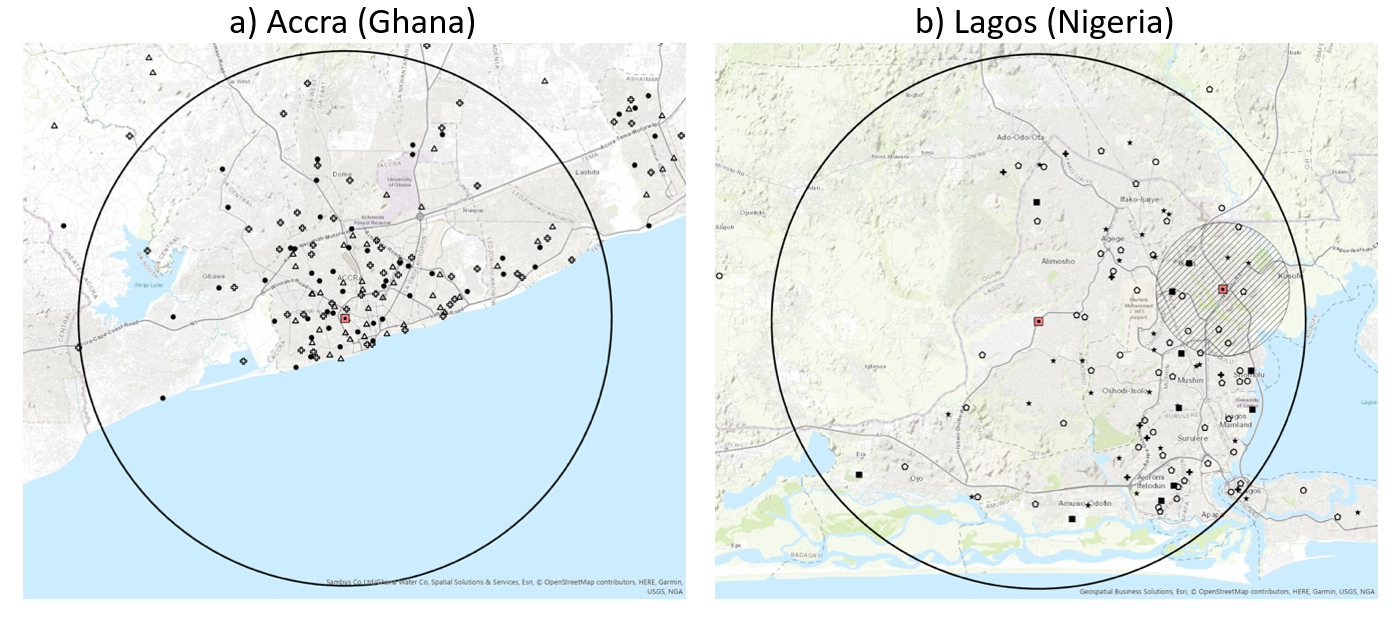
Evidence from Ghana and Nigeria shows that e-waste dumping is causing a health crisis, claiming the lives of newborns and infants living nearby.
A global surge in e-waste
Electronic waste (e-waste) is one of the fastest-growing waste streams in the world. In 2019 alone, the world generated 53.6 metric tons (Mt) of e-waste, a figure projected to rise to 74 Mt by 2030. On average, each person globally produced 7.8kg of e-waste in 2022, with Europe and North America leading the chart at over 20kg per capita (Baldé et al. 2024).
Despite international regulations such as the Basel Convention, which aims to control transboundary movements of hazardous waste, large volumes of e-waste continue to be shipped illegally to developing regions (Kellenberg 2010). In 2019, nearly 5 Mt of e-waste crossed borders, of which 3.3 Mt were shipped in an uncontrolled manner, labelled as used electronics or hidden inside second-hand products such as vehicles (Global Transboundary E-Waste Flows Monitor, Baldé et al. 2022). West Africa has emerged as a major hub for this trade, primarily receiving shipments from Europe and North America (Schluep et al. 2011).
Informal e-waste management
Many countries have national legislation that regulates the management and disposal of e-waste. Yet, e-waste management in developing countries is predominantly carried out by informal workers who dismantle components manually. In Lagos, for example, informal workers are often organised in small private associations. This labour-intensive process often involves burning unwanted materials or discarding them in open dumpsites. These practices release toxic substances such as lead, cadmium, and polychlorinated biphenyls (PCBs) into the environment.
Waste and health outcomes
While the broader effects of environmental pollution on child health have been well-documented, few studies have focused on dumping sites. A study on the US has shown that hazardous waste cleanups in the US have reduced the incidence of congenital anomalies by 20-25% (Currie et al. 2011). In Ethiopia, the construction of roads, which facilitated illegal hazardous waste disposal, was associated with a 3-percentage-point increase in infant mortality (Gennaioli and Narciso 2017). Evidence from mining waste in Italy further demonstrates that shutting down waste facilities significantly reduces mortality rates (Deiana and Giua 2023). Despite this growing body of evidence, the specific causal impact of e-waste—a rapidly expanding and poorly regulated waste stream—remains underexplored.
E-waste and child mortality in West Africa: Evidence from Accra and Lagos
In recent research (Lovo and Rawlings 2024), we investigate the impact of e-waste on child mortality considering two major e-waste sites in West Africa: Agbogbloshie in Accra, Ghana, and Solous II in Lagos, Nigeria. The Agbogbloshie dumpsite, established in 2001, spans 10 hectares and sits in a densely populated area with over 2 million residents within 10 kilometres. The site originated near a second-hand electronics market in Old Fadama slum, adjacent to the Odaw River. Solous II, established in 2006, is surrounded by 4 million residents within a 10-kilometer radius. A major road cutting through the site doubles as a trade route and business hub, amplifying the movement and impact of hazardous materials.
Figure 1: E-waste sites and household location

Note: Figures show DHS clusters across different surveys. Dumpsite locations are given by the squared points. The buffer represents 20 km from the e-waste site. The hatched buffer area in Nigeria shows the existence of the older dumpsite known as Olusoshun, not included in the analysis, and all clusters within this 5 km buffer are excluded from the analysis.
Using Demographic and Health Surveys (DHS) data, we analysed the health outcomes of children born within 20 Km of these sites over a 10-year period. Comparing children born before and after the sites became operational, our analysis revealed a clear and alarming pattern. Living near e-waste sites significantly increased both neonatal and infant mortality rates. The observed increase in mortality is not immediate but begins to manifest three years after the sites opened, which aligns with the gradual buildup of contaminants to critical levels in the surrounding environment. The effects are large, suggesting a 10-percentage-point rise in mortality rates for children living in proximity to these dumpsites compared to those farther away (Figures 2a and 2b).
Figure 2: Impact of proximity to e-waste sites on neonatal mortality (Panel A) and infant mortality (Panel B)

Note: Graphs are obtained considering both e-waste sites: Agbogbloshie and Solous II. Plots present event studies obtained implementing the Doubly Robust estimator in Callaway and Sant’Anna (2021), where treatment is defined by living within 5km from an e-waste site. The vertical lines indicate 95% confidence intervals.
One of the main challenges to the identification of causal effects of e-waste sites is the possibility that the creation of these sites might have induced some households to leave the area and/or attracted some households due to possible job opportunities in the scrapping business. Such in- and out-migration could affect mortality rates in either direction depending on the composition of the flows. To address this concern we compared siblings, whose mothers did not relocate during the period of analysis, born before and after the creation of the e-waste site. This analysis is possible only for the site in Accra, where the survey collects information on the migration status of mothers. We find that siblings born in the proximity of the site, after the creation of the e-waste site have a lower chance of surviving than their siblings born before, while this is not the case for children living further away from the site.
How does exposure to e-waste impact child health?
E-waste sites can affect health in different ways. One key pathway is water contamination. The Odaw River near Agbogbloshie frequently floods, carrying toxic runoff (known as leachate) from the dumpsite into local water supplies. Although this water is not typically used for drinking, it is often employed for cleaning, bathing, and urban agriculture. This creates indirect exposure to hazardous substances for nearby communities. When comparing children living downstream the River Odaw, we find larger effects on mortality than for those living upstream.
Another critical mechanism involves contaminated food products. Locally produced food, including animal and vegetable products, is a major route of exposure. Studies have revealed high levels of heavy metals in eggs and lettuce sampled near Agbogbloshie (Petrlik et al. 2019). Livestock, including cows and goats raised near the dumpsites, drink from contaminated water sources, introducing toxins into the food chain. In Accra, a slaughterhouse operates adjacent to one of Agbogbloshie’s burning areas, further compounding these risks. Our findings indicate that areas near e-waste sites with higher rates of urban animal farming experienced even greater increases in child mortality. This highlights the compounded risks that arise when environmental contamination intersects with local agricultural practices.
Another possible route of exposure is air pollution from burning of electronic equipment. We could not investigate this channel due to a lack of data. However, observational studies have found exceptionally high concentrations of particulate matters attributed to burning of e-waste in both sites (Aderemi and Falade 2012; Kwarteng et al. 2020). As air pollution is a well-known cause of infant mortality, this pathway likely represents a significant contributor to adverse health outcomes.
References
Aderemi A, and T Falade (2012), "Environmental and health concerns associated with the open dumping of municipal solid waste: A Lagos, Nigeria experience," American Journal of Environmental Engineering 2(6): 160–165.
Baldé CP, R Kuehr, T Yamamoto, R McDonald, E D’Angelo, S Althaf, G Bel, O Deubzer, E Fernandez-Cubillo, V Forti, V Gray, S Herat, S Honda, G Iattoni, DP Khetriwal, V Luda, Y Lobuntsova, I Nnorom, N Pralat, M Wagner (2024), Global E-Waste Monitor 2024, United Nations Institute for Training and Research (UNITAR), International Telecommunication Union (ITU), Geneva/Bonn.
Baldé CP, E D’Angelo, V Luda, O Deubzer, and R Kuehr (2022), Global Transboundary E-Waste Flows Monitor 2022, United Nations Institute for Training and Research (UNITAR).
Callaway B, and PH Sant’Anna (2021), "Difference-in-differences with multiple time periods," Journal of Econometrics 225(2): 200–230.
Currie J, M Greenstone, and E Moretti (2011), "Superfund cleanups and infant health," American Economic Review 101(3): 435–441.
Deiana C, and L Giua (2023), "This site is closed! The effect of decommissioning mining waste facilities on mortality in the long run," Journal of Environmental Economics and Management 119: 102797.
Kellenberg D (2010), "Consumer waste, backhauling, and pollution havens," Journal of Applied Economics 13(2): 283–304.
Kwarteng L, EA Baiden, J Fobil, J Arko-Mensah, T Robins, and S Batterman (2020), "Air quality impacts at an e-waste site in Ghana using flexible, moderate-cost and quality-assured measurements," GeoHealth 4(8): e2020GH000247.
Gennaioli C, and G Narciso (2017), "Toxic roads: Unearthing hazardous waste dumping," CGR Working Papers 82, Queen Mary, University of London, School of Business and Management, Centre for Globalisation Research.
Lovo S, and S Rawlings (2024), "The health burden of e-waste: The impact of e-waste dumping sites on child mortality," The World Bank Economic Review, lhae053.
Petrlik J, J Puckett, L Bell, and J DiGangi (2019), "Weak controls: European e-waste poisons Africa’s food chain," IPEN and BAN Report.
Schluep M, A Manhart, O Osibanjo, D Rochat, N Isarin, and E Mueller (2011), "Where are WEEE in Africa? Findings from the Basel Convention E-Waste Africa Programme," Published by the Secretariat of the Basel Convention.


